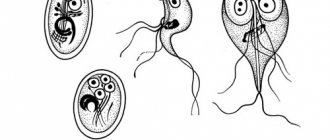If you have pain, dryness, soreness, a feeling of a “lump” in the throat, painful swallowing, then most likely it is inflammation of the mucous membrane of the back wall of the pharynx - pharyngitis . The throat with pharyngitis is red and inflamed.
Treatment of this disease must begin as early as possible, when the first symptoms appear. This will help avoid serious complications. Our clinic receives daily consultations from experienced otolaryngologists, candidates and doctors of medical sciences.
Causes of pharyngitis in children
Pharyngitis occurs due to the ingress of various viruses and bacteria.
There are also a number of factors
that increase the likelihood
of developing the disease:
- hypothermia;
- decreased immunity;
- throat irritation from smoke, dust and chemicals;
- lack of vitamins and microelements;
- diseases of the stomach and intestines;
- disruption of the endocrine system;
- allergic reactions.
Acute pharyngitis can also be a manifestation of inflammatory pathology of the upper respiratory tract, intestinal and general infections, etc. Viruses have little effect on the development of the disease. Usually this is a herpes and influenza virus, enterovirus, adenovirus. Among the bacterial pathogens are Haemophilus influenzae, moraxella, diplococci, streptococci of groups C, A, G, etc.
Pharyngitis can develop against the background of a fungal infection. In general, pharyngitis of viral origin accounts for 70% of cases, bacterial and other – 30%. Pharyngitis can be accompanied by measles, ARVI, scarlet fever, etc. In some cases, the causes may be foreign bodies in the pharynx or burns in this area. The chronic form of the disease is usually associated with other diseases of the ENT organs of an inflammatory nature - adenoiditis, rhinitis, stomatitis, sinusitis, tonsillitis, etc.
Risk factors
Risk factors contributing to the development of pharyngitis include:
- the child eating food that is too cold (for example, ice cream);
- improper breathing (through the mouth), especially in winter;
- low level of immunity;
- lack of vitamins in the body;
- diseases of the gastrointestinal tract and endocrine system.
Allergic reactions can also provoke the occurrence of pharyngitis.
Free consultation on training issues
Our consultants are always ready to tell you about all the details!
Types of disease
According to the nature of the course, the disease is divided into:
- acute – lasts up to 1 month;
- protracted – lasts more than six months with frequent exacerbations;
- chronic - can occur in several forms - atrophic, catarrhal, hypertrophic.
according to the condition of the mucous membrane :
- catarrhal – characterized by swelling and redness of the mucous membranes;
- hypertrophic - with it the mucous membrane thickens because the epithelium grows;
- subatrophic - the mucous membrane becomes thinner and atrophies.
Classification
Based on the course, acute, subacute and chronic forms of pharyngitis are distinguished. There is also a classification based on the condition of the pharyngeal mucosa. With catarrhal pharyngitis, the pharynx looks swollen, hyperemic, with the mucous membrane gradually acquiring a characteristic gray-pink hue. With the hypertrophic form of pharyngitis, the mucous membranes of the larynx and pharynx become thicker, with hypertrophic growth of ridges on the side of the pharynx. The palatine arches also thicken, and granulosa and nodular formations are observed at the back of the pharynx.
The subatrophic type of pharyngitis leads to focal or diffuse thinning of tissue. In this case, the mucous membranes look pale, atrophied, with thinned blood vessels.
Symptoms and signs of pharyngitis in a child
The main signs of pharyngitis in children are:
- moderate pain;
- sore throat.
Hoarseness of voice and dry cough may also be observed. And with the reflux nature of the disease, there is a feeling of bitterness in the mouth.
In the acute form, the signs are as follows:
- dry throat, rawness, burning, soreness when swallowing;
- hoarseness of voice;
- shallow cough;
- high temperature if the disease develops against the background of a virus;
- headache;
- signs of general intoxication;
- enlargement of regional lymph nodes. Source: T.V. Kulichenko, A.M. Kabaloeva, Yu.S. Lashkova, M.A. Lazareva Diagnosis of acute pharyngitis in children // Pediatric pharmacology, 2014, v. 11, no. 4, pp. 59-66
In infants, the disease is more severe:
- sleep disturbance;
- fever;
- salivation;
- decreased appetite;
- swallowing disorder;
- conjunctivitis;
- runny nose;
- rashes on the body;
- discomfort and pain in the upper abdomen.
The chronic hyperplastic form is characterized by thickening of the mucous and submucosal layer, lymphoid tissues, dryness and sore throat, urge to vomit, painful swallowing, which radiates to the ear. Sometimes hearing loss develops because thickened tissue blocks the openings of the auditory tubes.
Usually, with pharyngitis, the temperature rises slightly. Temperatures above 38-39 degrees can only be observed if the tonsils are involved in the process.
If your child has a high fever, you should immediately consult your doctor. Experts do not recommend treating tonsillitis in a child without supervision from a pediatrician, since if treated incorrectly, the disease can lead to complications.
If pharyngitis does not go away for a long time, then it is necessary to look for the true cause of the disease.
Complications
Pharyngitis is a safe disease that responds well to treatment, provided it is properly managed. If a chronic form develops, in which the symptoms become permanent, it poses a great danger and is difficult to treat. She often quotes:
- to chronic bronchitis;
- laryngitis;
- tracheitis.
Free consultation on training issues
Our consultants are always ready to tell you about all the details!
In severe cases, the development of peritonsillar abscess or acute rheumatism of the joints is possible (if pharyngitis was caused by group A beta-hemolytic streptococcus).
Diagnostic methods
The diagnosis and treatment of tonsillitis in a child is carried out by a pediatrician or otolaryngologist. This disease must be distinguished from other infectious pathologies, including diphtheria and catarrhal tonsillitis. Therefore, you should also contact a pediatric allergist-immunologist and infectious disease specialist. After the examination, the doctor will prescribe laboratory tests (smear for microflora and sensitivity to viruses, bacteria, general blood test. Source: https://www.ncbi.nlm.nih.gov/pmc/articles/PMC5807738/ Thea Brennan-Krohn, Al Ozonoff and Thomas J. Sandora Adherence to guidelines for testing and treatment of children with pharyngitis: a retrospective study // BMC Pediatr. 2018; 18: 43
For recurrent forms of the disease, endoscopy of the nose and nasopharynx, consultation with an allergist, examination by a gastroenterologist, and endoscopy of the larynx will be required. All this is necessary to identify the true nature of the pathology.
There are three forms of chronic pharyngitis:
1. Catarrhal.
In this case, inflammation of the pharyngeal mucosa does not in any way change the structure of its tissues. Usually this form develops in the initial stages of chronic pharyngitis.
3. Atrophic.
With this disorder, the mucous membrane of the pharynx becomes thinner and thinner over time, and its secretory function suffers. This form of pharyngitis is especially dangerous for the development of various infectious complications, since it is now much easier for pathogenic microorganisms to attach to epithelial cells that are not protected by mucus. Atrophic pharyngitis is characteristic primarily of smokers.
3. Hypertrophic.
Here, inflammation primarily affects the lymphoid tissue on the back wall of the pharynx, causing it to become red, overgrown, and swollen. There may also be an increase in the size of the tonsils and lymph nodes located in the neck.
Treatment of pharyngitis in children
How to treat this pharyngitis depends on the root cause of this disease in children . It is also necessary to eliminate unpleasant symptoms and generally strengthen the body.
Treatment of pharyngitis in a child includes:
- gargling with herbal decoctions or antiseptics (for children over three years old);
- antiseptics - for rinsing and local - lozenges and lozenges;
- anti-inflammatory drugs;
- antibacterial therapy;
- a gentle diet (excluding foods that irritate the mucous membrane);
- inhalation with a nebulizer to moisturize the mucous membrane with solutions based on mineral waters. Source: T.A. Polunina, E.V. Vishneva Pharyngitis in children // Pediatric pharmacology, 2011, vol. 8, no. 5, pp. 106-108
Also for the treatment of pharyngitis, antihistamines are indicated to relieve swelling, humidify the air in the room to facilitate breathing, inhalation, and vocal rest.
It is advisable that the child’s diet include food that does not irritate the throat - pureed, liquid, soft, non-spicy.
How to treat pharyngitis to cure it?
Experienced otolaryngologists recommend modern methods for the treatment of pharyngitis, which are characterized by high efficiency, a short rehabilitation period and excellent tolerability by patients. These methods include laser destruction of the lymphoid tissue of the pharynx.
The manipulation is performed on an outpatient basis using local infiltration or topical anesthesia.
Laser destruction of lymphoid tissue is used in the treatment of chronic hypertrophic lateral pharyngitis, granulosa, to remove remnants of lymphoid tissue after tonsillectomy or benign neoplasms. The advantages of the method include:
- Bloodlessness.
- Well tolerated by patients.
- The manipulation is relatively painless.
- Does not require prophylactic use of antibiotics and anti-inflammatory drugs.
- Does not contribute to the formation of rough scars at the site of the removed tissue.
Clinical recommendations for prevention
It is necessary to strengthen the child’s immunity - carry out regular hardening exercises, adjust the diet so that healthy and vitamin-rich food predominates in it, and take walks in the fresh air more often. In addition, it is necessary to promptly and completely cure infections of the respiratory tract and oral cavity, not to cause caries, otitis media, sinusitis, and stomatitis. It is important to prevent and promptly treat gastrointestinal diseases. To prevent the disease from becoming chronic, you must consult a doctor in a timely manner.
The children's medical department has all the capabilities to treat various diseases, including pharyngitis. Doctors at the medical center will diagnose and prescribe treatment as soon as possible.
Sources:
- T.V. Kulichenko, A.M. Kabaloeva, Yu.S. Lashkova, M.A. Lazarev. Diagnosis of acute pharyngitis in children // Pediatric pharmacology, 2014, vol. 11, no. 4, pp. 59-66.
- https://www.ncbi.nlm.nih.gov/pmc/articles/PMC5807738/ Thea Brennan-Krohn, Al Ozonoff and Thomas J. Sandora. Adherence to guidelines for testing and treatment of children with pharyngitis: a retrospective study // BMC Pediatr. 2018; 18:43.
- T.A. Polunina, E.V. Vishneva. Pharyngitis in children // Pediatric pharmacology, 2011, vol. 8, no. 5, pp. 106-108.
Zaichenko Vladislav Sergeevich Clinic
Author of the article
Zaichenko Vladislav Sergeevich
Specialty: otolaryngologist
Experience: 18 years
The information in this article is provided for reference purposes and does not replace advice from a qualified professional. Don't self-medicate! At the first signs of illness, you should consult a doctor.
Prevention of pharyngitis
Everyone knows that it is much easier to prevent a disease than to subsequently treat it. In order to avoid the development of pharyngitis, the following rules must be followed:
- Try not to overcool the body.
- Limit the consumption of cold and hot foods, as well as the intake of cold and hot drinks.
- Stop smoking in the presence of your child.
- Regularly carry out wet cleaning of rooms.
- Make sure that your breathing is correct (the child should breathe through his nose - this is how the air warms up and is neutralized).
- Visit a doctor promptly if there is any suspicion of pathology of the throat and nose.
By following these rules, you can reduce the risk of developing ENT diseases in your child to a minimum.
“SM-Doctor” is a specialized clinic for children and adolescents, staffed by qualified specialists who regularly improve their professionalism. We examine and treat children in accordance with world-class medical guidelines. “SM-Doctor” provides only reasonable diagnostics and proven effective treatment. Contact professionals so that your child has good health and strong immunity!
Complications of pharyngitis due to improper self-medication and lack of treatment
The spread of infection leads to complications of an inflammatory nature: sinusitis, otitis, bronchitis, etc. But the long-term consequences of streptococcal pharyngitis pose a much greater danger. This microorganism provokes immune aggression against the body's own tissues, which causes endocarditis - inflammation of the inner lining of the heart, glomerulonephritis - pathology of the kidneys and joints.
Long-term consequences can lead to disability and even death of the child.








